(Step 3 of 9 in the Bed Bugs Killer Ultimate Guide - Updated March 5, 2020)
(Note: As an Amazon Associate, this site earns from qualifying purchases. This article may contain affiliate links. If you purchase anything after clicking an affiliate link, we may receive compensation.)
Clutter is a bed bug’s friend. One of the best ways to make these blood suckers feel unwelcome is to eliminate their safe hiding places. If you've detected bed bugs, the next step is to undertake a thorough "bed bugs cleaning" process. Cleaning for bed bugs means no more clutter.
Your main focus will be your family's living areas – bedrooms, the living room, the family room, the home office, the TV or entertainment room – places where you sleep or lounge on chairs or sofas when you relax.
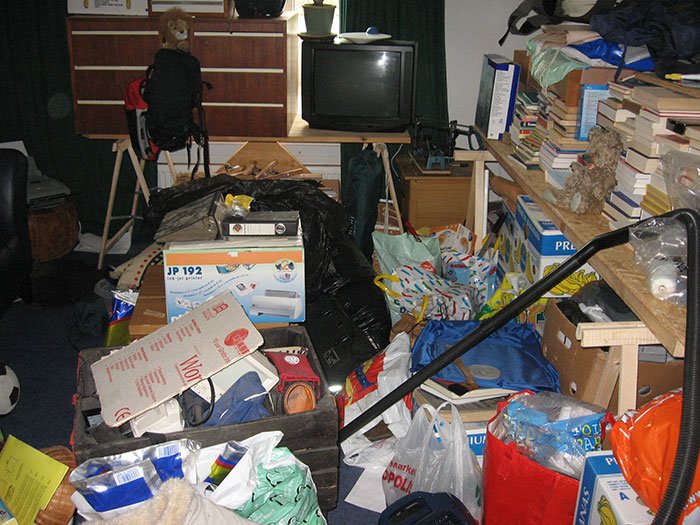
Face it, getting rid of bed bugs means you're going to have to become a bit of a neat freak.
You must begin removing clutter before you apply any insecticides or the other methods discussed in this guide. If you have not removed the clutter in each of your rooms yet, you're not ready to proceed further with the treatment process.
Warning: If you detected bed bugs, do not move items from one room to another. This will only spread the infestation.
Make Your Bedroom Clutter-Free First
Bedrooms are critical because you sleep there, and you are the most important thing in a bed bug's world.
Here’s how to clean bed bugs in your bedroom.
First, realize that if you detected bed bugs, everything in the room needs to be treated. Everything. So you need to make one of the following decisions about every item in the room:
- 1Throw it out because you no longer need it or want it.
- 2Keep it and treat it.
- 3Quarantine it. Keep it even though you can't treat it without damaging it. Instead, you'll need to quarantine it by storing it for up to 18 months.
Choose one of the three for everything: beds and bedding, clothing, books, toys, drawer contents, knickknacks, keepsakes, pictures and their frames, furniture, curtains, clocks, TVs, computers, and other electronics. Everything.
Isolate Your Bed from Bed Bugs
It's esential that you rob bed bugs of easy access to your bed, so move it away from any wall – at least 6 inches. Make it an island in your room. Nothing on your bed should touch the floor, any wall, a nightstand, or anything else a bed bug can climb to reach your bed. Remember, bed bugs can't fly. They must crawl to get to your bed and you, so create a 360-degree barrier around your bed.
Next, strip your bed. Place all your bedding into a large plastic bag or a bin and seal it until you can get to a washing machine. Wash everything in very hot water (at least 120°F, 49°C). Then, dry it on high heat for at least 45 minutes.
Empty Your Closets and Drawers
Then, take everything out of your closets and drawers. If it's washable, wash it in hot water and dry it on high heat for at least 45 minutes. If it's not washable, put it in the dryer on high heat for at least one hour. If it needs to be dry cleaned, take it to the cleaners in a plastic bag you have sealed shut. Be sure to give the cleaners a heads-up, so they don't mix your clothing with others.
Quarantine or toss everything else. For items that are not safe to wash, dry, or dry clean, you'll need to store them in a safe container (e.g., garbage bags or sealed plastic bins) for about 18 months to ensure they do not harbor bed bugs. Why 18 months? Because bed bugs can survive in them for more than a year without a meal.
Do not return these items to your room until all treatments have been completed. Store them in safe containers until all signs of bed bugs are gone to protect them. Nothing goes back into your room until the bed bug threat has been eliminated.
For bedding and clothing you wear everyday, plan to repeat this laundering cycle frequently until all signs of bed bugs are gone. from containers each day as you need them. Store clothing in plastic bins and take out what you need for the day. Return them to the containers after washing them again.
Here's a quick look at how to handle your personal belongings after you've cleaned and heated them for at least 45 minutes.
It's probably easiest to separate clothing based on how soon you're likely to wear it (i.e., whether it's in season, only for special occasions, or daily wear).
Use a large plastic trash bag, large ziploc bag, or a container you can lock and seal. You can find these items at your local Target, Wal-Mart, or office supply store or online at Amazon.
The ZappBug heater is handy if it fits in your budget but not necessary to get the job done. However, if you don't have a washing machine or you travel a lot, the ZappBug heater might be worth the investment for you. You might also be able to use this to bed bug–proof some items that you can't wash or dry clean. We'll review this portable heater in an upcoming article.
Declutter the Floor
Next, get everything off the floor that doesn’t belong on the floor. This is particularly important for items under your bed. Don’t leave anything under your bed. If you have bed bugs, they will snuggle into those items and make themselves at home. And they will use them to gain access to you and your bed during the night.
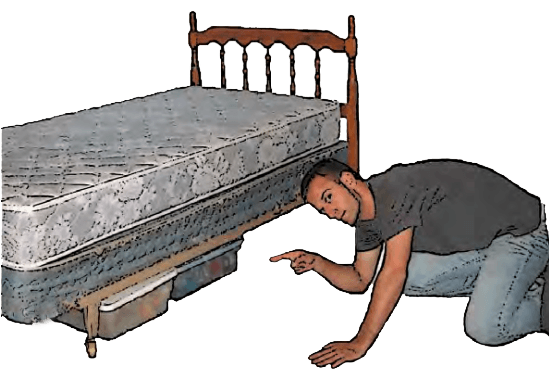
Credit: New York State Integrated Pest Management Program
Also, get rid of any cardboard boxes in the room. Cardboard provides perfect hiding places for bed bugs. Don't even take the chance; just get rid of them.
How to Make Non-Clothing Items Safe
Keep going and inspect any non-clothing items for bed bugs and eggs. If they’re free of infestation and you want to keep them, you have a decision to make. Everything left in the room will need to be treated in some way or bagged and sealed until the threat is over.
Place anything you can't wash or dry but want to keep into a bed bugs–free container for about 1½ years.
For the items you decide to get rid of, bag and seal them with tape before placing them in the trash. Do not give these items away to other people.
To discourage others from searching through the bag, label it with a warning. You don’t want to spread this infestation.
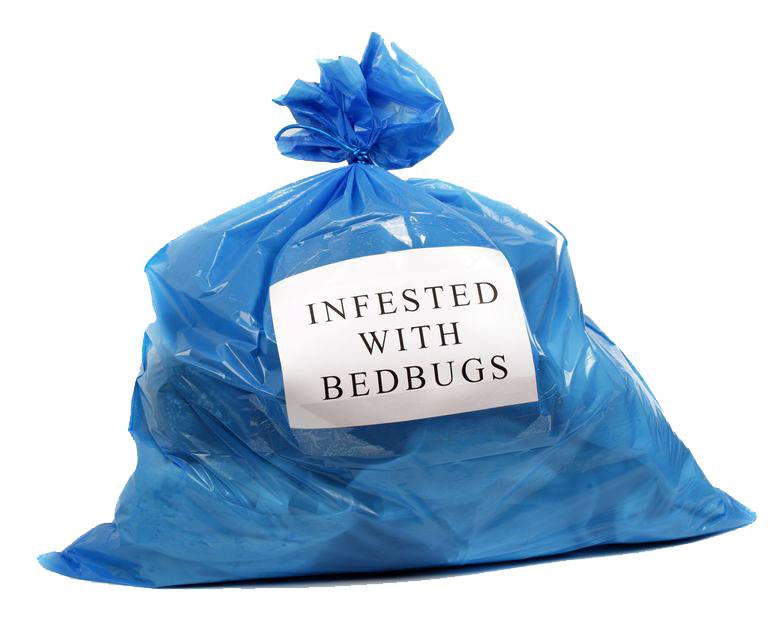
Books present a special challenge for many people. Here's how to protect your books while containing them to ensure bed bugs can't use them as a secure hiding place.
Vacuum to Start Deep Cleaning
Once you complete the clutter removal, you’re ready to go deeper. Deep cleaning, including vacuuming, is an invaluable tool in your beg bug elimination toolbox.
After you get everything off the floor, vacuum the area. If you can, use a vacuum cleaner that will only be used for this purpose. This is because bed bugs can cling inside the hose and spread to other non-contaminated rooms.
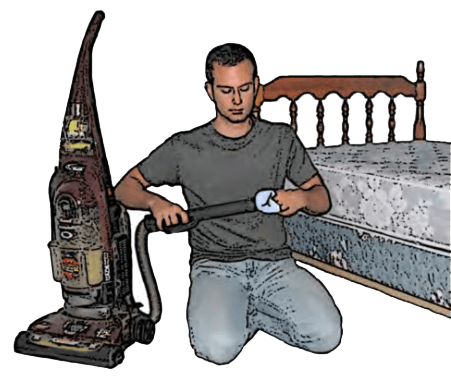
Credit: New York State Integrated Pest Management Program
If using an old, disposable vacuum cleaner is not an option, at least plug the hose with a thick cloth to prevent escape by bed bugs when you're finished. (Another tip is to cover the hose with panty hose or an old sock. When finished vacuuming, take the vacuum cleaner outside, remove the panty hose or old sock and tie it in a knot to keep any bed bugs inside from escaping. Then, toss it into the trash.)
Immediately empty the vacuum bag and its contents into a heavy-duty (2 – 3 mil thick) garbage bag and seal it with duct tape. Throw it into the trash outside. Don’t leave this bag in your home.
Of course, the vacuum cleaner has to be thoroughly cleaned after use. Use hot soapy water and be thorough. It's best to use a vacuum cleaner that has a HEPA filter and uses bags. Dispose of the bag when finished. (Do not use a bagless vacuum cleaner for this task.)
Use Vacuum Attachments to Suction Crevices
Use your attachments to suction your bedding and the upholstered fabric in sofas and chairs. The more powerful the vacuum, the better.
Vacuum to remove live bed bugs, their shed skin, feces, and other signs. Use the wand attachment to get:
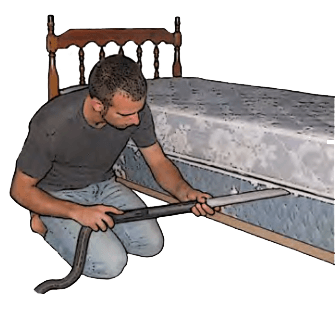
Credit: New York State IPM Program
Don't forget to suction screw holes and nail holes. They are some of bed bugs' favorite hiding places.
Press the wand against surfaces and apply a scraping motion to loosen attached bed bugs and their eggs.
Vacuum all furniture in the room, paying special attention to the insides and underneath drawers.
By itself, vacuuming is not going to get rid of all bed bugs, nor most of their eggs. But it will remove some that other methods don’t, and the objective is to stack weapons until you achieve a wipeout.
Vacuuming also makes it easier to see how large any existing population is, especially after treatment with insecticides.
After disposing of the contents in a sealed bag, make sure to wash the vacuum cleaner attachments in hot, soapy water. As an added protection, seal the vacuum in a heavy-duty trash bag until it's time to use it in follow-up bed bugs maintenance.
What about Floors, Rugs, and Carpets?
Cleaning bed bugs that have lodged themselves in your carpets can be challenging. Obviously, rugs and carpeting provide ideal hiding places for bed bugs and their eggs. Similarly, they are all but impossible to see with the untrained eye on floors. So how do you treat these areas to ensure you don't leave behind bed bugs who can re-populate and continue flourishing throughout your home?
Thoroughly vacuum floors, rugs, and carpets. No, this won't kill bed bugs or their eggs but it will remove many of them. Always think in terms of "Here's one more way to get rid of more of them," because no one method applied alone is going to kill all of them. Here are a few tips from the experts on cleaning for bed bugs in your carpets, rugs, and floors:
- 1Don't sweep the floors. This helps spread bed bugs and their eggs from one room to the next.
- 2Ensure the vacuum cleaner has a disposable bag, so you can take the captured bed bugs directly to the trash outside.
- 3Sprinkle diatomaceous earth on the floors, rugs, and carpet before vacuuming. It will mix with the bed bugs in the bag and help speed up their demise. Use the vacuum wand to suction the crevices in your floor or tile. Be sure to wear a mask to avoid breathing in the dust. And be sure to vacuum up all the diatomaceous earth.
- 4Immediately, vacuum a second time, this time without adding any diatomaceous earth.
- 5Immediately dispose of the vacuum bag when finished.
- 6Toss rugs into the dryer on high heat for 45 minutes (if they are dryer-safe). An alternative is to purchase a portable heat chamber and use it to treat rugs regularly.
- 7If you have a carpet cleaning machine, use it on your carpets after vacuuming with diatomaceous earth. It won't kill bed bugs because the water does not get hot enough. It just adds one more weapon that can dislodge bed bugs and their eggs, making it easier to remove them. (Of course, you'll need to clean the machine when finished.)
Now ... Scrub
You're not through cleaning for bed bugs yet.
Because eggs can attach themselves to surfaces and be difficult to dislodge, use a stiff brush to wash down the surfaces of walls, furniture, the bed frame, baseboards, inside and under drawers, doors, windowsills, closets, and other places they can settle.
Give special attention to anything made of wood or fabric.
Skip the bleach and ammonia. They don't work. You want hot soapy water. Orange, lemon, and pine-based soaps are especially effective, so try to use one of these.
Steam Cleaning Bed Bugs in Mattresses
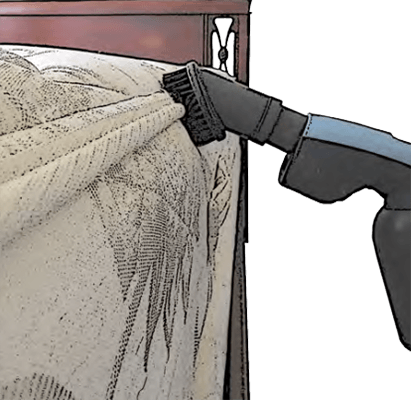
Credit: New York State IPM Program
Steam, applied directly, kills bed bugs on contact. The important thing is it has to make contact. Bed bugs love to hide in the seams of mattresses and box springs. So after, you declutter, vacuum, and scrub, apply steam directly to those areas of your bed.
Watch the video below to see how to apply steam to a mattress properly to kill bed bugs.
Two points from the video are worth repeating: this is a slow, deliberate process. Move the steamer head about one-inch per second to ensure effective coverage. Also, the steamer head needs to be large enough to avoid applying so much pressure that it blows bed bugs away before killing them. So do not use a pinpoint nozzle. Look instead for a triangular-shaped or flat attachment. These will do the job.
This is one reason a blow dryer would not be effective in killing bed bugs. Even though it gets very hot, the blower makes the heat too forceful. This would cause the bed bugs to scatter before the heat has time to kill them. Also, do not use a steamer intended to take wrinkles out of clothing or a carpet cleaning machine (on the mattress). Neither gets hot enough to kill bed bugs.
Notice also that the technician covers the steamer head to control the amount of liquid that gets applied to the mattress with the steam. This protects the fabric and keeps it from getting too wet.
Disposal after Cleaning for Bed Bugs
As you complete each of these steps, ask yourself what happens next to these pests. Make sure that by moving them, you don’t leave them in a position to cause more harm to the rest of your home, your neighbors, or local businesses. Remember, you’re not through until they’re dead or encased in an inescapable package.
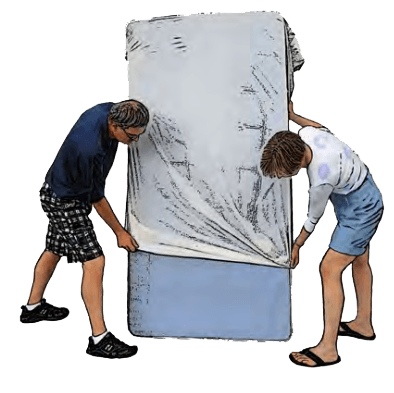
Credit: New York State IPM Program
When you remove the clutter, you'll probably find things you're ready to toss because they no longer fit into your life. Assume that these items may be infested, and make sure you wrap them in plastic or bag them in a sealable package before you set them out.
Mattresses and box springs that have bed bugs inside them may not be salvageable. If you decide your mattress, box spring, or bed frame is too infested to keep, don’t pass it on to someone else. Before removing the mattress or box spring from your home, cover it or wrap it in plastic and tape it shut.
The only safe place for these items is the dump. Before setting these out on the curb for pickup, deface, break, or label them. You don't want any unsuspecting person to take them home and inherit this problem.
Attach a sign for dumpster or curbside hunters, warning them these items are being discarded because they are bed-bug infested. Yes, it might be embarrassing, but it’s the right thing to do.
Next: Begin Application of Treatments
Two things are critical for effective bed bugs cleaning:
- 1Do not move items to other rooms in the house.
- 2Anything that you bag and seal to keep must stay that way until all bed bugs are gone. This means storing any items you could not treat for up to 1½ years.
Repeat the process for other bedrooms, the living room, and other places where people lie down or sleep in the house. If you found bed bugs in more rooms, declutter and clean every room.
Once you've completed a thorough bed bugs cleaning process, you're ready to begin applying treatments to kill them.
Did You Miss the Previous Steps in the Guide?
In case you missed it, click to read previous steps:
(Note: This article contains affiliate links. If you purchase anything after clicking an affiliate link, we may receive compensation.)
